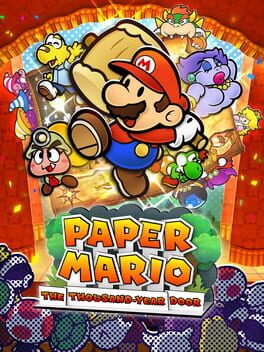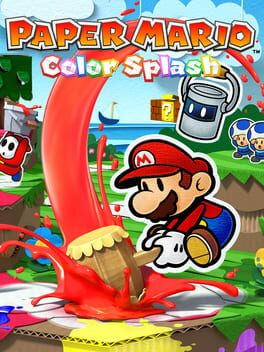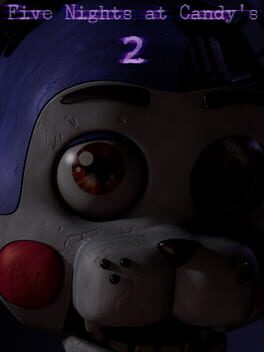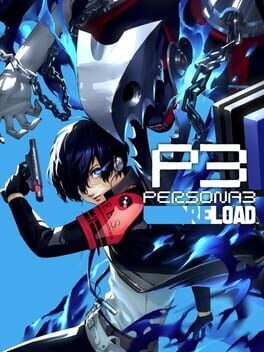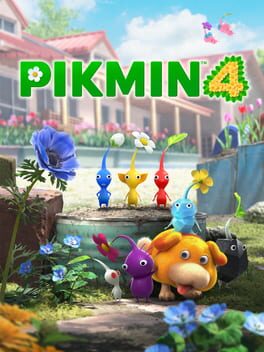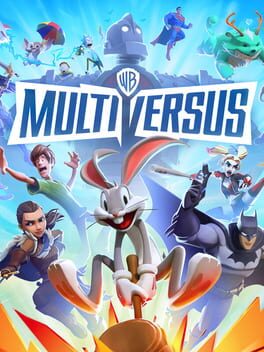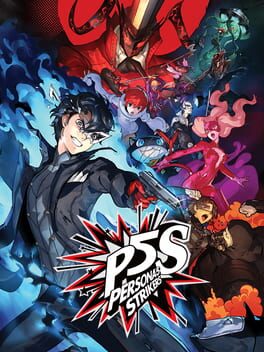Jaynosurname
556 Reviews liked by Jaynosurname
Part of what’s been drawing me toward JRPGs as a genre as of late has been the way different games emphasize different parts of its core. For as similar as many JRPGs look on the surface - battle systems, overworlds, big stories and big numbers - there’s always a lot of choices made by individual development teams on where their game’s full focus should lay. Because if the aspects I just listed all have one thing in common, its that they’re all often aiming to be as big and vast in scope as possible. In stretching the focus of a game’s development too thin to achieve the highest quality across all aspects, many games wind up biting off more than they can chew, and become flawed, bloated messes as a result.
This is, in part, what made Paper Mario: Color Splash so intriguing to me. It, along with its much-derided prequel, was one of the first instances I’ve yet seen of a JRPG franchise actively aim to re-pivot their focus to a drastic degree.
The quality of a newer Paper Mario game can never really be discussed without first addressing the series’ first two games: Paper Mario and Paper Mario: The Thousand Year Door. These games, much like Super Mario RPG before it, adapted the complexities of normal JRPG combat into a fantastic, streamlined, yet still nuanced and fun set of systems to welcome Mario fans to a more tactical form of play. Celebrated as the games may have been, something was definitely lost in that transition from platformer to JRPG - Though combat is smart and cleverly thought through, the worlds that tie them together are often barren in design, nothing more than a means to deliver more battles and more narrative. The focus of the original Paper Mario games was placed almost entirely on combat and story, while turning level design and the player’s interactions with said levels into somewhat of an afterthought.
Though its easy to write the series' third game off as merely an experimental side-game, its hard to play Super Paper Mario without getting the sense that the developers were unsure where to take their RPG sub-series after its first two entries. They’d succeeded in making an RPG combat system that was simple to understand but deviously fun to play around with, yet in the process of doing so abandoned almost everything that defined the act of playing Super Mario. That is of course the nature of spin-offs in some sense - to offer a different play experience to the real thing - yet I can’t help but feel as if the developers at Intelligent Systems felt frustrated in their inability to do more with the Mario branding as part of their games’ DNA. And despite a bumpy first attempt in Paper Mario: Sticker Star, I do believe they captured something special in their second go around at this new direction. Five games in, and Paper Mario was finally beginning to rediscover its own voice.
The amount of flack that Sticker Star and its following sequels would receive was inevitable, as the areas in which they evidently failed are the ones that Paper Mario used to succeed effortlessly in. The combat mechanics in all three games are half-baked at best and completely mindless at worst, as even the genuine effort to present more depth to combat in Paper Mario: The Origami King ended up messy and poorly thought through. All three games are infamously lacking in narrative depth, with conflicts so simple that two of them simply involve Bowser harnessing a new power to cause mayhem without ever evolving beyond that. The Origami King’s effort to place a new antagonist in charge doesn’t do much to change that the story is tragically one-note in progression and depth. This shallowness applies to the cast of characters the games sport, with the amount of total new characters introduced across all three games sitting below double digits. Once again The Origami King pushes its head against the ceiling more, with more distinctly characterized bosses and temporary party members, yet its held back by the amount of compromises each of these characters come packaged with in their execution.
As the latest entry in the series and the one pushing hardest to overcome its weaknesses, you may be surprised to find that I’m less fond of The Origami King than far safer Wii U game its a sequel to. This brings us back to what I discussed at the very start of the review - the troubles in stretching a project too thin, and for developers to pick a direction and stick with it. While all of The Origami King’s efforts are commendable, I find it leads to a somewhat messier and less clear-cut experience on the whole compared to Color Splash.
Color Splash has a complete waste of a combat system and a very shallow, uninteresting story. Yet with those two things set aside, I find that the developers were instead able to place their focus on refining everything else as part of the package. The reduced scope in comparison to its sequel feels almost directly related to the game’s biggest strength: Color Splash is overall a fantastically snappy, well paced out adventure. By using the level-by-level structure of Sticker Star to its advantage, it gives each section of the game a very clearly defined start and endpoint, allowing a breezy journey befitting of the game’s vacation-island theming. Part of what really helps sell the pace is the core mechanic of coloring in the environment across every level, effectively a set of collectibles strewn about every part of the game like Star Coins in New Super Mario Bros. Levels can now not only just be beaten, but 100%:ed with little hassle, and seeing a flag raised across each of the many levels in the game never stops being satisfying. The amount of visual variety also helps, as the game’s color palette is as varied as its title would suggest and never lets up on creative, pleasant environments for Mario to bounce between. The entrance to a water-themed prison base turns out to be an out-of-nowhere underwater game show, a train heist is stopped before it can begin by the passenger’s need to stop for a meal Mario has to help cook up, the haunted mansion sits next to an aristocratic park flooded with poison - when paired with a surprisingly open-ended structure in level progression, it never feels as if you’re in one environment for too long.
It’s through stuff like this that the shift in focus compared to the Paper Mario games of old is most apparent: The level design is impressively fun across the whole game, asking the player to be perceptive, do simple platforming, solve puzzles, and occasionally have fast reflexes, to clear individual levels before moving onto the next. Even though combat depth may have careened off a cliff, this amount of effort placed into the game’s level design is a far cry from the endless sets of corridors that filled The Thousand Year Door. It becomes all the more interesting to think about when compared to the aforementioned Super Paper Mario, which despite its similar efforts to de-emphasize the RPG-ness of gameplay, still couldn’t find much of a purpose to its gameplay-first design and wound up falling back on an engrossing narrative first and foremost. I believe it speaks magnitudes to Color Splash’s strengths that its able to remain engrossing and genuinely fun for its entire runtime without much of any overarching narrative for the player to follow.
Color Splash sets out to give players a fun time exploring a big world split up into bite-sized chunks, and does so with buckets of charm. Every level in the game is home to some sort of setpiece that makes it stick out in your mind, or further sells a joke that could’ve well just been presented in a dialogue box. Huey as a character isn’t anything particular as a companion to Mario, yet his comments keep the tone of the game consistently gleeful - though the actual events driving the conflict could have easily been framed as gruesome and serious, the game remains content in just giving you a good, harmless experience. The game is outrageously funny across the board: be it through slapstick or sharp writing with pitch-perfect localization, it never lets too many moments go by without almost wringing a smile out of you. This commitment to a feel-good experience is part of why I can’t really be too upset with the combat system being as flimsy as it is: The game bends over backwards to ensure that you never have a tough time with combat, handing out cards and paint at every step and always clearly communicating what specific Thing-cards are needed to beat each world’s boss. Really, with all three aforementioned resources, it’s almost as if the main purpose of the combat in the game is to drive you to explore even more - a feedback loop of rewarding your exploring with faster and less tedious battles.
I’ve grappled with this concept ever since I first started thinking about the JRPGs I liked and disliked - a good combat system isn’t really needed to make a good JRPG, so long as things are built around it. Most JRPGs offer easy modes that turn combat into a complete formality (Pokémon practically forces you into it), yet these playthroughs are still enjoyed by the fun found elsewhere in the game. Then again, a game like Final Fantasy XIII manages to catch scrutiny for its lack of world design, despite having one of the best combat systems in the franchise. A lot of people simply don’t gel with the balance between combat and non-combat being tipped too far into one direction, yet I often find games become far less impressive on the whole when the two end up worse than they could be due to each other. Had Final Fantasy XIII had layered, intensely designed dungeons with layers of movement mechanics and collectibles to watch out for, a player’s focus would diverge from the actual meat of the game in the combat - the player’s attention would be spread almost as thin as that of the developers. And while I'm not arguing that Color Splash would've been a worse game had it had an actually interesting combat system, I do believe the developers chose the right thing to prioritize.
In the end, Paper Mario: Color Splash isn’t a game meant to blow you away as the JRPG that solved all the genre’s issues or hurdles, nor one meant to awe you with its scale. Much like the Wii U itself, it sits contently in the corner knowing its downplayed ambitions were enough to make some people happy. And I’m glad to be one of those people.
[Play Time: 30 Hours]
[Key Word: Content]
This is, in part, what made Paper Mario: Color Splash so intriguing to me. It, along with its much-derided prequel, was one of the first instances I’ve yet seen of a JRPG franchise actively aim to re-pivot their focus to a drastic degree.
The quality of a newer Paper Mario game can never really be discussed without first addressing the series’ first two games: Paper Mario and Paper Mario: The Thousand Year Door. These games, much like Super Mario RPG before it, adapted the complexities of normal JRPG combat into a fantastic, streamlined, yet still nuanced and fun set of systems to welcome Mario fans to a more tactical form of play. Celebrated as the games may have been, something was definitely lost in that transition from platformer to JRPG - Though combat is smart and cleverly thought through, the worlds that tie them together are often barren in design, nothing more than a means to deliver more battles and more narrative. The focus of the original Paper Mario games was placed almost entirely on combat and story, while turning level design and the player’s interactions with said levels into somewhat of an afterthought.
Though its easy to write the series' third game off as merely an experimental side-game, its hard to play Super Paper Mario without getting the sense that the developers were unsure where to take their RPG sub-series after its first two entries. They’d succeeded in making an RPG combat system that was simple to understand but deviously fun to play around with, yet in the process of doing so abandoned almost everything that defined the act of playing Super Mario. That is of course the nature of spin-offs in some sense - to offer a different play experience to the real thing - yet I can’t help but feel as if the developers at Intelligent Systems felt frustrated in their inability to do more with the Mario branding as part of their games’ DNA. And despite a bumpy first attempt in Paper Mario: Sticker Star, I do believe they captured something special in their second go around at this new direction. Five games in, and Paper Mario was finally beginning to rediscover its own voice.
The amount of flack that Sticker Star and its following sequels would receive was inevitable, as the areas in which they evidently failed are the ones that Paper Mario used to succeed effortlessly in. The combat mechanics in all three games are half-baked at best and completely mindless at worst, as even the genuine effort to present more depth to combat in Paper Mario: The Origami King ended up messy and poorly thought through. All three games are infamously lacking in narrative depth, with conflicts so simple that two of them simply involve Bowser harnessing a new power to cause mayhem without ever evolving beyond that. The Origami King’s effort to place a new antagonist in charge doesn’t do much to change that the story is tragically one-note in progression and depth. This shallowness applies to the cast of characters the games sport, with the amount of total new characters introduced across all three games sitting below double digits. Once again The Origami King pushes its head against the ceiling more, with more distinctly characterized bosses and temporary party members, yet its held back by the amount of compromises each of these characters come packaged with in their execution.
As the latest entry in the series and the one pushing hardest to overcome its weaknesses, you may be surprised to find that I’m less fond of The Origami King than far safer Wii U game its a sequel to. This brings us back to what I discussed at the very start of the review - the troubles in stretching a project too thin, and for developers to pick a direction and stick with it. While all of The Origami King’s efforts are commendable, I find it leads to a somewhat messier and less clear-cut experience on the whole compared to Color Splash.
Color Splash has a complete waste of a combat system and a very shallow, uninteresting story. Yet with those two things set aside, I find that the developers were instead able to place their focus on refining everything else as part of the package. The reduced scope in comparison to its sequel feels almost directly related to the game’s biggest strength: Color Splash is overall a fantastically snappy, well paced out adventure. By using the level-by-level structure of Sticker Star to its advantage, it gives each section of the game a very clearly defined start and endpoint, allowing a breezy journey befitting of the game’s vacation-island theming. Part of what really helps sell the pace is the core mechanic of coloring in the environment across every level, effectively a set of collectibles strewn about every part of the game like Star Coins in New Super Mario Bros. Levels can now not only just be beaten, but 100%:ed with little hassle, and seeing a flag raised across each of the many levels in the game never stops being satisfying. The amount of visual variety also helps, as the game’s color palette is as varied as its title would suggest and never lets up on creative, pleasant environments for Mario to bounce between. The entrance to a water-themed prison base turns out to be an out-of-nowhere underwater game show, a train heist is stopped before it can begin by the passenger’s need to stop for a meal Mario has to help cook up, the haunted mansion sits next to an aristocratic park flooded with poison - when paired with a surprisingly open-ended structure in level progression, it never feels as if you’re in one environment for too long.
It’s through stuff like this that the shift in focus compared to the Paper Mario games of old is most apparent: The level design is impressively fun across the whole game, asking the player to be perceptive, do simple platforming, solve puzzles, and occasionally have fast reflexes, to clear individual levels before moving onto the next. Even though combat depth may have careened off a cliff, this amount of effort placed into the game’s level design is a far cry from the endless sets of corridors that filled The Thousand Year Door. It becomes all the more interesting to think about when compared to the aforementioned Super Paper Mario, which despite its similar efforts to de-emphasize the RPG-ness of gameplay, still couldn’t find much of a purpose to its gameplay-first design and wound up falling back on an engrossing narrative first and foremost. I believe it speaks magnitudes to Color Splash’s strengths that its able to remain engrossing and genuinely fun for its entire runtime without much of any overarching narrative for the player to follow.
Color Splash sets out to give players a fun time exploring a big world split up into bite-sized chunks, and does so with buckets of charm. Every level in the game is home to some sort of setpiece that makes it stick out in your mind, or further sells a joke that could’ve well just been presented in a dialogue box. Huey as a character isn’t anything particular as a companion to Mario, yet his comments keep the tone of the game consistently gleeful - though the actual events driving the conflict could have easily been framed as gruesome and serious, the game remains content in just giving you a good, harmless experience. The game is outrageously funny across the board: be it through slapstick or sharp writing with pitch-perfect localization, it never lets too many moments go by without almost wringing a smile out of you. This commitment to a feel-good experience is part of why I can’t really be too upset with the combat system being as flimsy as it is: The game bends over backwards to ensure that you never have a tough time with combat, handing out cards and paint at every step and always clearly communicating what specific Thing-cards are needed to beat each world’s boss. Really, with all three aforementioned resources, it’s almost as if the main purpose of the combat in the game is to drive you to explore even more - a feedback loop of rewarding your exploring with faster and less tedious battles.
I’ve grappled with this concept ever since I first started thinking about the JRPGs I liked and disliked - a good combat system isn’t really needed to make a good JRPG, so long as things are built around it. Most JRPGs offer easy modes that turn combat into a complete formality (Pokémon practically forces you into it), yet these playthroughs are still enjoyed by the fun found elsewhere in the game. Then again, a game like Final Fantasy XIII manages to catch scrutiny for its lack of world design, despite having one of the best combat systems in the franchise. A lot of people simply don’t gel with the balance between combat and non-combat being tipped too far into one direction, yet I often find games become far less impressive on the whole when the two end up worse than they could be due to each other. Had Final Fantasy XIII had layered, intensely designed dungeons with layers of movement mechanics and collectibles to watch out for, a player’s focus would diverge from the actual meat of the game in the combat - the player’s attention would be spread almost as thin as that of the developers. And while I'm not arguing that Color Splash would've been a worse game had it had an actually interesting combat system, I do believe the developers chose the right thing to prioritize.
In the end, Paper Mario: Color Splash isn’t a game meant to blow you away as the JRPG that solved all the genre’s issues or hurdles, nor one meant to awe you with its scale. Much like the Wii U itself, it sits contently in the corner knowing its downplayed ambitions were enough to make some people happy. And I’m glad to be one of those people.
[Play Time: 30 Hours]
[Key Word: Content]
Not gonna lie, this...is pretty good. I liked the ideas presented in Sticker Star, but felt it had awful execution. Color Splash takes everything Sticker Star set out to do, vastly improves on it, and has an actual story, good dialogue and even better gags on top of that. This is a very well-designed and enjoyable game.
OBJECTIVELY, yes it is very flawed. do i care? not really man
my favorite Paper Mario game to date and it’s not even close. the soundtrack, the environments, the writing, and CHARACTERS (yes it has those lol) all are just amazing. it’s not trying to be TTYD 2, and i respect that a lot. it’s rarely dark or brooding, but it’s oozing with so much charm and originality as previous games if you’re willing to give it a chance
lots of people complained about the Koopalings being the main villains, but i strongly disagree. they are fleshed out and given actual personalities for the first time, maybe ever. they are great and steal the show whenever they are on screen. the same can’t really be said for their previous appearances, so to equate them as the same shows a disregard for the writing
the levels are expansive and varied too. i understand disliking the level map system, but i think it totally works here. it’s nice, it helps keep everything organized, and the levels never felt sacrificed because of the map design
anyways, yeah i love Color Splash. it’s my new favorite Paper Mario game and i will forever talk about how it is the peak of the franchise. go play it, please. give it a second chance if you didn’t like it before
my favorite Paper Mario game to date and it’s not even close. the soundtrack, the environments, the writing, and CHARACTERS (yes it has those lol) all are just amazing. it’s not trying to be TTYD 2, and i respect that a lot. it’s rarely dark or brooding, but it’s oozing with so much charm and originality as previous games if you’re willing to give it a chance
lots of people complained about the Koopalings being the main villains, but i strongly disagree. they are fleshed out and given actual personalities for the first time, maybe ever. they are great and steal the show whenever they are on screen. the same can’t really be said for their previous appearances, so to equate them as the same shows a disregard for the writing
the levels are expansive and varied too. i understand disliking the level map system, but i think it totally works here. it’s nice, it helps keep everything organized, and the levels never felt sacrificed because of the map design
anyways, yeah i love Color Splash. it’s my new favorite Paper Mario game and i will forever talk about how it is the peak of the franchise. go play it, please. give it a second chance if you didn’t like it before
Persona 3 Reload
2024
There is absolutely not enough I can say about Persona 3. Loved every part of this game from beginning to end. Persona 3 specifically holds a special place in my heart as it was my very first exposure to this series. Saw a friend play it and thought it looked interesting so I picked up Persona 5. Been a huge fan of this series since then. Everything in Reload is exactly what I wanted out of a remake for this game. Incredible presentation, outstanding music, and unforgettable characters that I will hold close to my heart for as long as I remember. I love Persona.
Pikmin 4
2023
This game should be nearly perfect, especially with the amazing addition of Oatchi and night missions. But their decision to cater a lot of the systems in this game to people who've never played a Pikmin game creates so many small annoyances, and I have a hard time recommending this over Pikmin 3 Deluxe (which is the best Pikmin game for my money, and the one to start with if you're interested in the series). It's death by a thousand cuts, and every cut was an issue this game made for itself.
MultiVersus
2022
Being assaulted by an unskippable, hand-holdey, ignorant tutorial full of very obvious information and an onslaught of paragraphs describing 3 different currencies and how a goddamn battle pass works is a really great introduction to a somehow even worse feeling re-release. Nothing says "Smash-killer" like a game so ignorant of it's own target audience that it pretends anyone playing this game hasn't already played Smash about 1000 times before.
Heaven Studio
2024
Heaven Studio
2024
Heaven Studio
2024
Heaven Studio
2024
Persona 5 Strikers
2020
I am so unbelievably confused why this game didn't release after Royal. While nothing in this game contradicts what happens in Royal, the lack of characters like Sumi and Maruki make the cast feel incomplete. It's even more striking when you realize that a lot of these plot points, notably with Sophia and Kuon, are remarkably similar to Royal. What it makes up for it is the quality of the writing, and the incredibly fun dungeons (jails) and boss encounters. As far as Warrior-styled crossover games goes, this one is probably the most complete package.
